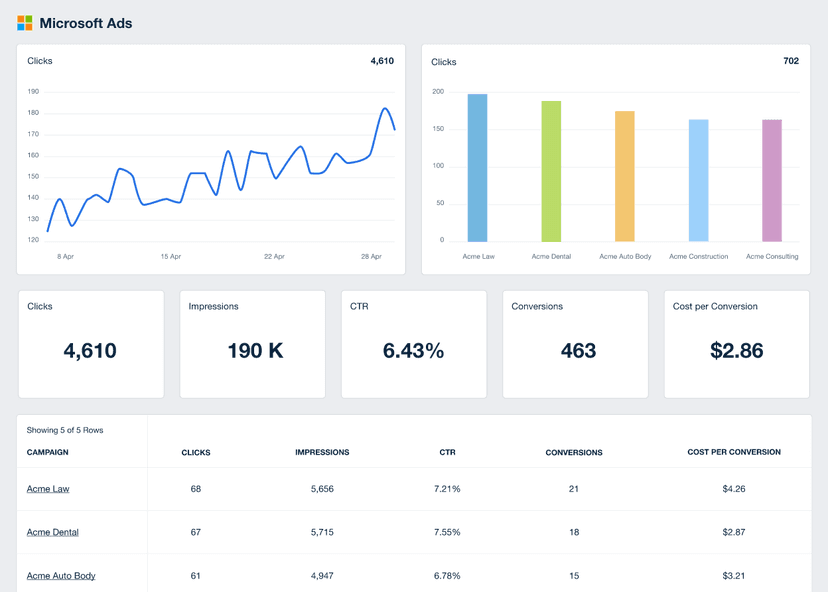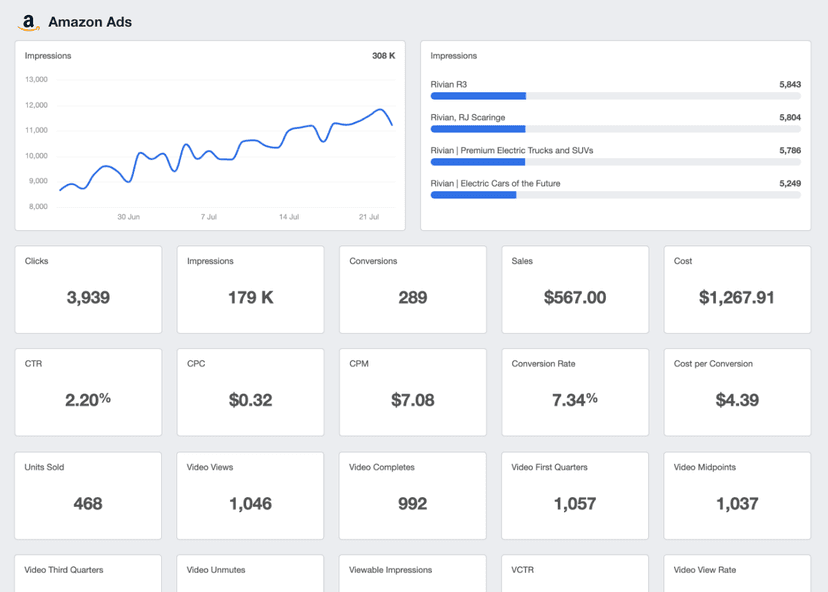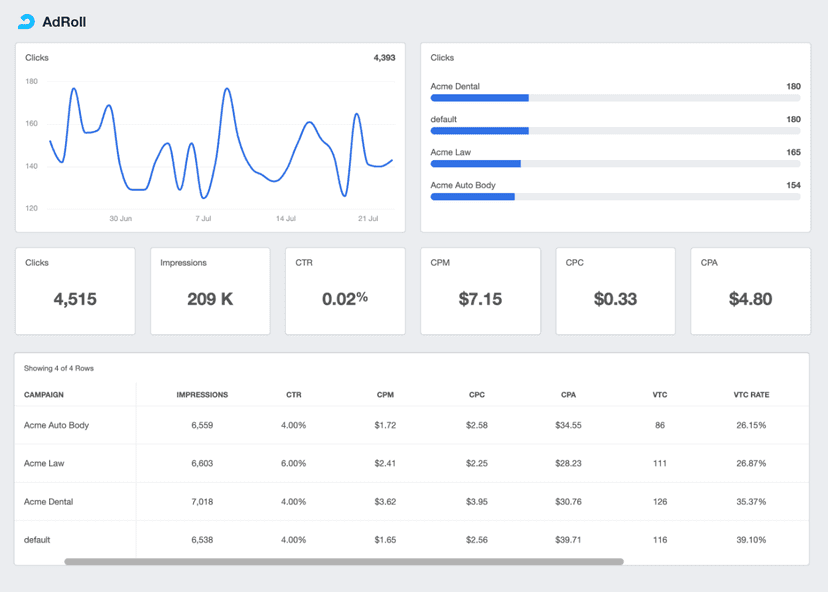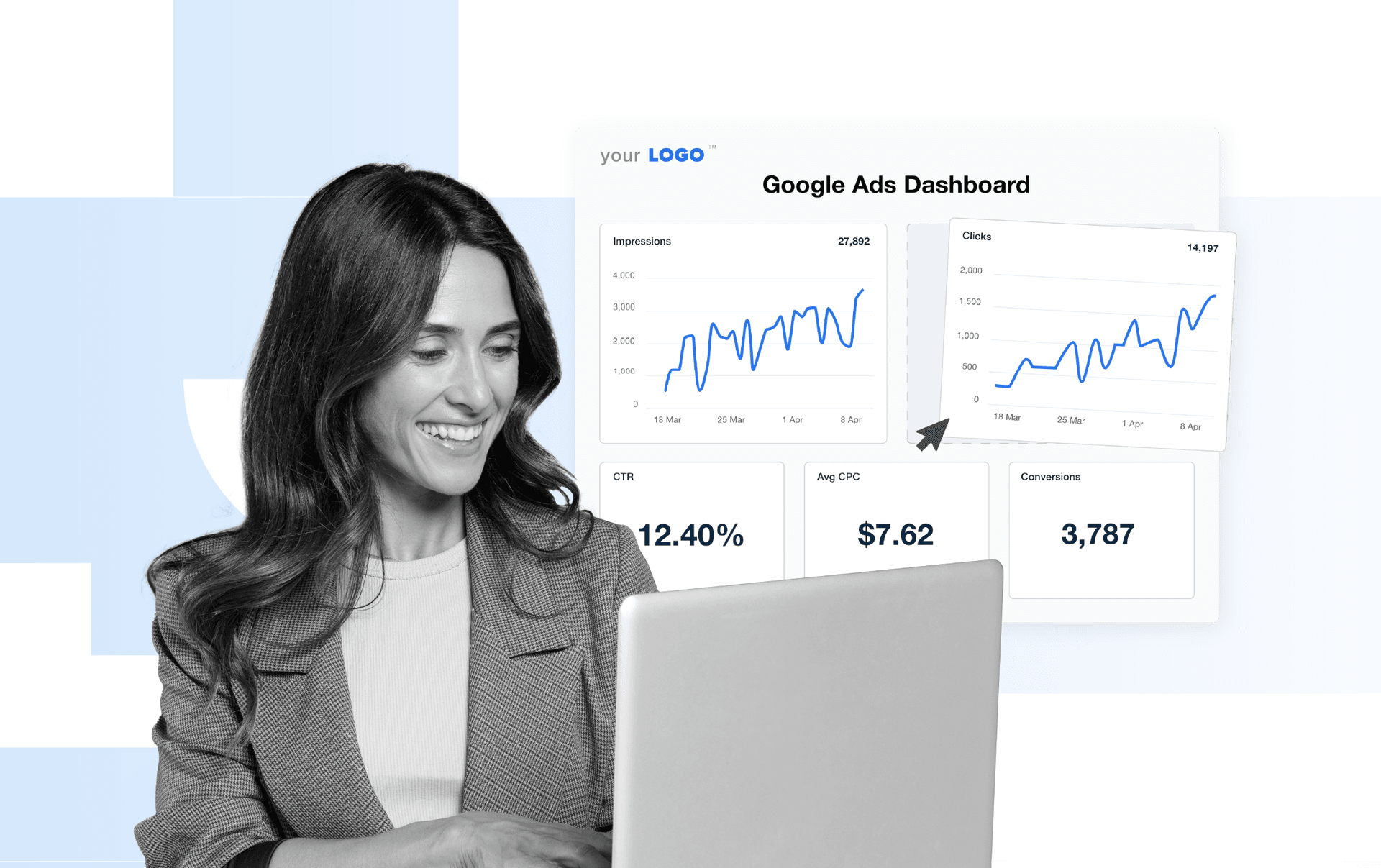Ad Position
Bid Strategies
A higher ad position typically costs more, so balancing the budget with performance is crucial.
Keyword Optimization
Use Ad Position to identify strong and weak keywords for bidding.
Ad Copy Tests
Leverage Ad Position for targeted A/B testing to improve ad quality and ad relevance.
Client Reports
Highlight creative capabilities by showcasing growing impression share in search results.
Why Tracking Ad Position Matters
Ad Position plays a critical role in determining how visible an ad is on search engine result pages. How well an ad ranks typically correlates with greater visibility, giving it a better chance of getting clicks and conversions. While Google no longer provides this distinct metric, it remains a key player behind the scenes, impacting and informing Impression Share KPIs.
Securing a prime Ad Position in Google Ads involves multiple elements. Bid amount and Quality Score are foundational; a higher bid can secure a better position, but a superior Quality Score can also elevate an ad, even with a lower bid. The utility of ad extensions and other ad formats shouldn't be underestimated; these aspects contribute to a better user experience, positively affecting position. Competition levels, device type, and even geo-targeting and timing play roles in determining Ad Position.
If an ad fails to achieve a solid Impression Share, revisiting these factors becomes key to boosting campaign performance and getting more eyeballs on client ads.

Stop Wasting Time on Manual Reports... Get PPC Insights Faster With AgencyAnalytics
How Ad Position Relates to Other KPIs
Ad Position directly impacts–and is directly impacted by–Cost Per Click (CPC). A top spot ensures visibility and is likely to garner more clicks, but it often comes with a higher CPC. Conversely, a lower position might result in a more cost-effective CPC but less visibility. It's a balancing act between achieving increased visibility and effectively managing costs.
Conversion Rates and Return on Ad Spend (ROAS) also weigh into the equation. A lofty Ad Position does not always equate to higher conversion rates or better ROAS. Sometimes, a lower position, albeit with a lower Clickthrough rate, can yield more qualified leads, leading to higher conversions and a better ROAS.

How Ad Position is Displayed in Google Ads
Even though Google retired the absolute Ad Position metric in 2019, there are still several ways to measure the overall positioning of an ad relative to the competition.
Impression Share: The ratio of actual to possible impressions for an ad, but without any indication of where on the page it is displayed.
Top Impression Share: Frequency of an ad appearing above organic results, typically the first 1 - 3 results.
Absolute Top Impression Share: Percentage of time an ad occupies the first Ad Position, which marks peak visibility.
Bidding for Optimal Ad Position
While an ad may consistently hold the top Ad Position, if the CPC is high and the Conversion Rate is not up to expectations, the increased visibility will eat up the marketing budget without generating adequate returns.
Recognizing that visibility isn't translating into profitability, agencies often lower the bids to aim for the second or third position. This strategic move decreases CPC substantially, enabling more clicks with the same budget. Notably, the Conversion Rate also improves because the traffic is now more qualified—people are genuinely interested in the product rather than just clicking the top result. By adjusting the Ad Position and not vying for the top spot, the agency optimizes both CPC and Conversion Rate, ultimately enhancing the campaign's ROAS.
Essentially, the strategic positioning of an ad influences not just its visibility but also how much bang an agency can get for the client’s advertising buck.

Carry out competitor analysis regularly – even if it’s just checking in on your auction insights once a week. This way, you can anticipate any drops in performance and react to them before they have a negative impact on the account. For instance, if you see sudden increases in average CPC or your impression share drops, you can get some strategies in place to combat these before they’ve even had a chance to take hold!
How To Measure Ad Position
Ad Position is a ranking system determined by Google Ads that dictates where an ad appears on the search engine results page. Although they no longer display this metric in the Google Ads interface, understanding the difference between Impression Share, Top Impression Share, and Absolute Top Impression Share provides invaluable insights into how frequently an ad appears in coveted spots.
What Is a Good Ad Position?
Although typically more expensive to acquire, the Top Ad Position between 1 and 3 will mean that the ad consistently appears on the first page and near the top of search engine results, likely yielding higher visibility and clicks.
What Is a Bad Ad Position
An average position below 4 can indicate reduced visibility and fewer clicks. Ads in these lower positions appear at the bottom of the page or on subsequent pages, significantly reducing impression share and engagement.
How To Set Ad Position Benchmarks
Agencies often refer to historical data to set custom benchmarks, examining past performance metrics like CPC, Conversion Rate, and ROAS, all relative to Ad Position. They align these data points with client goals to tailor unique KPI targets.
Agencies segment Ad Positions by device type, geographic location, or time of day to get a more nuanced understanding. This offers a granular view of how Ad Position impacts campaign performance in specific scenarios, allowing for more targeted optimizations.
Why Ad Position Matters to Clients
For clients, Ad Position serves as a straightforward gauge of visibility. An ad that consistently ranks high will be viewed by a broader audience, thus raising brand awareness and increasing market share.
Being front and center also adds an extra layer of credibility; a top position often equates to industry leadership in the minds of consumers. It also helps push competitors out of the spotlight, offering a bit of market protection. For them, it's not just about being seen; it's about being seen as a frontrunner in a competitive market.

Why Ad Position Matters to Agencies
Ad Position is not just about securing the top spot but understanding its impact on a broader performance landscape. While a high position typically yields impressive click-through rates, agencies also weigh it against KPIs like CPC, Conversion Rates, and ROAS to ensure they maximize every dollar spent.
For example, being in the top spot might generate high visibility but could also lead to unsustainable levels of spend. Agencies need to strike a balance, often opting for a slightly lower but more cost-effective position that achieves a solid ROI while still delivering on visibility and engagement. In this way, Ad Position serves as both a measure of performance and a pivot point for strategy adjustments.

Save Time and Money By Automating Your Client Reporting
Best Practices When Analyzing and Reporting on Ad Position
Understanding Ad Position through multiple lenses creates a foundation for more effective, ROI-positive advertising efforts. By diving into its details, marketers adjust bids and tactics to optimize visibility and budget.
Time-Based Ad Position Analysis
Examining how Ad Position fluctuates over time provides insights into seasonal trends, competition fluctuations, or the effectiveness of optimizations. This historical context helps PPC experts make informed future strategies, from bidding to ad optimization.
Campaign-Specific Breakdown
Campaigns differ in their objectives, affecting their Ad Position priorities. For instance, lower positions might be acceptable for non-branded or lower-intent keywords. In contrast, branded or navigational keywords likely demand higher positions.
Deciphering Position Fluctuations
Noticing an unexplained spike or drop in Ad Position? Digging into the data behind these anomalies helps uncover impactful insights–from algorithm changes to new ad formats or competitor activities–that could require rapid strategy adjustments.
Put Ad Position in Context
It's easy to misinterpret Ad Position as a standalone figure, but its real value shines when contextualized with other KPIs like total spend, budget pacing, CPC, conversion rates, and ROAS. Doing so shows precisely how the agency is maximizing the impact of the client’s budget.
Visualize Ad Position Data
Graphs, pie charts, or line charts add a dynamic layer to the static numbers. Visualization helps clients intuitively understand the fluctuations and trends in Ad Position over time or across campaigns. Visual data storytelling doesn't just make reports more engaging; it facilitates quicker decision-making by highlighting key patterns and outliers.
Connect to Client Goals
Ad Position isn't just a vanity metric; it directly contributes to a client's bottom line when leveraged appropriately. Connecting Ad Position to crucial business goals like brand awareness, customer acquisition, or revenue growth becomes a strategic component in a comprehensive marketing strategy.
FAQs about ad position
Still have questions about ad position? Don’t worry—we’ve got you covered.
Ad position refers to the order in which your ad appears on a search engine results page. A position of “1” means your ad showed up first above all other ads. Overall, lower numbers indicate better visibility and higher chances of clicks.
Ad position in Google Ads is determined by your ad rank, which combines your bid amount, ad quality, landing page experience, expected impact of extensions, and search context. It’s not just about how much you spend—relevance matters.
Ad position impacts visibility, click-through rates, and ultimately ROI. Agencies must track this KPI to ensure clients are getting maximum exposure for their budget and to adjust strategy when ads consistently appear too low.
Average ad position shows where your ad typically appears in search results, while ad rank is a score that determines if and where your ad appears. Ad rank is the calculation; ad position is the result.
To improve ad position, agencies should boost ad quality, refine keyword targeting, improve landing pages, and use relevant ad extensions. More than raising bids, it’s about increasing value and relevance to the user.
Google Ads Dashboard Example

Related Integrations
How To Improve Ad Position
Ad Position is more than just a number; it reflects an ad's effectiveness and efficiency. Don’t just bid your way to the top. Focus on critical campaign optimizations to boost this vital metric.
Optimize Keywords
Scrutinize keyword lists to weed out low-performing keywords and focus on those that bring quality traffic. Better keywords often mean better Ad Position.
Improve Ad Quality Score
Ad quality is all about relevance, landing page experience, and CTR. Pay attention to these elements to improve the quality score and Ad Position.
Leverage Extensions
Use ad extensions like callouts, site links, or structured snippets to improve CTR and, by extension, the Ad Position. More clicks usually result in a better position.
Related Blog Posts
See how 7,000+ marketing agencies help clients win
Free 14-day trial. No credit card required.





![The Ultimate Google Ads Optimization Checklist [Guide & Tips] An Easy to Follow Guide to Google Ads Optimization + a Downloadable Checklist](/_next/image?url=https%3A%2F%2Fimages.ctfassets.net%2Fdfcvkz6j859j%2F1RGRDTvZOx2bH3PCJMjDsD%2Fc239f0aed512ea0e761f3713dd6e59ac%2FGuide-to-Google-Ads-Optimization-Checklist.png&w=1920&q=75)






